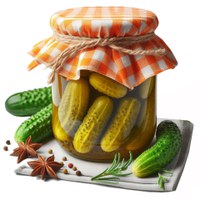Prairie Fare: Pick a pickled or pickle-flavored product
(Click an image below to view a high-resolution image that can be downloaded)
I picked up some dill pickle-flavored chips the other day. The chips were crisp, tart and a bit addictive. I had to put the bag in the kitchen out of my reach. Next time, I will follow my own advice and put a serving in a bowl and the bag in the cupboard.
Pickle-flavored foods have become increasingly popular in the last few years. We can buy pickle-flavored tortilla chips, pretzels, meat sticks, mustard, ketchup, pistachios, sunflower seeds, popcorn, and even pickle-flavored cotton candy and soda in some stores.
I am not so sure about the pickle-flavored cotton candy or soda, although I would be willing to try them.
I grew up eating all sorts of homemade pickles, including beet, bread and butter, dill and all sorts of relish. In fact, pickles were a side item at most of our meals.
Pickles are not new foods by any stretch of the imagination. Food historians believe pickled products have been around for at least 4,000 years.
We may be familiar with the history of using citrus fruits, including limes, by British Navy members. Vitamin C-rich foods are needed to prevent scurvy, and the sailors were nicknamed “limeys” as a result.
Early explorers, including Columbus, provided pickles to their crew to help prevent life-threatening scurvy. Some of the fresh fruits did not last the voyage, but the pickled vegetables did.
Pickling was probably discovered by accident many years ago. Some adventuresome science-type person probably poured or spilled over-fermented wine on some vegetables. Some brave soul tasted the vinegar-flavored vegetables and survived.
Modern-day pickling uses brine made from vinegar, salt, water and spices. The brine is poured over the food. Pickles are very acidic as a result, and the brine stops many types of bacteria from growing.
Unfortunately, most of us are aware of a type of bacteria, called Listeria monocytogenes, linked with recent deaths associated with deli meats in some parts of the country.
Listeria can grow in refrigerator temperatures, including within improperly pickled foods stored in the refrigerator. If you decide to make your own refrigerator pickles, be sure to use research-tested recipes.
In fact, use research-tested recipes for all your canned foods that will be stored on your kitchen shelves. Do not alter vinegar, water or salt in the pickling brine. Be sure that pickling vinegar has an acidity of 5% acetic acid. The percentage is on the label.
If you want to try your hand at pickling, see “Making Pickled Products” (FN189) on the NDSU Extension website (www.ag.ndsu.edu/food). The pickling recipes include dill, bread and butter, several relishes, hot peppers, mixed vegetables, three-bean salad, beets and green beans.
Although I am sometimes asked for pickled egg recipes for canning, we do not have a tested consumer recipe to share. Your best bet is to make these tasty appetizers as needed and store them in your refrigerator. These recipes are courtesy of “Peter Piper Picked A Peck of Pickled Eggs” by the Georgia Egg Commission.
3 Types of Pickled Eggs (for Refrigerator Storage)
Hard-cook eggs according to your desired method. Cool immediately and peel.
Each of these brine recipes makes enough brine to pickle 12 eggs.
Brine No. 1 for Dilled Eggs
1½ cups white vinegar
1 cup water
¾ teaspoon dill weed
¼ teaspoon white pepper
3 teaspoons salt
¼ teaspoon mustard seed
½ teaspoon onion juice or minced onion
½ teaspoon minced garlic or 1 peeled garlic clove
Brine No. 2 for Red Beet Pickled Eggs
1 cup red beet juice (from canned beets)
1½ cups cider vinegar
1 teaspoon brown sugar
A few canned whole tiny red beets (or several slices of beets can be used)
Brine No. 3 for Dark and Spicy Eggs
1½ cups cider vinegar
½ cup water
1 tablespoon dark brown sugar
2 teaspoons granulated sugar
1 teaspoon mixed pickling spice
¼ teaspoon liquid smoke or hickory smoke salt
2 teaspoons salt
For each type of egg, bring all the ingredients except the eggs to a boil, reduce the heat and simmer for 5 minutes. Pack no more than one dozen peeled, hard-cooked eggs loosely into a warm, pre-sterilized quart jar (or other similar-sized container that can be closed tightly). There needs to be plenty of pickling solution, and enough to completely cover the eggs. Pour the hot pickling solution over the eggs in the jar, cover, and refrigerate immediately. If small eggs are used, 1 to 2 weeks are usually allowed for seasoning to occur. Medium or large eggs may require 2 to 4 weeks to become well seasoned. Keep refrigerated. Use the eggs within 3 months for best quality.
(Julie Garden-Robinson, Ph.D., R.D., L.R.D., is a North Dakota State University Extension food and nutrition specialist and professor in the Department of Health, Nutrition and Exercise Sciences.)
NDSU Agriculture Communication – Sept. 6, 2024
Source: Julie Garden-Robinson, 701-231-7187, julie.garden-robinson@ndsu.edu
Editor: Elizabeth Cronin, 701-231-7006, elizabeth.cronin@ndsu.edu




